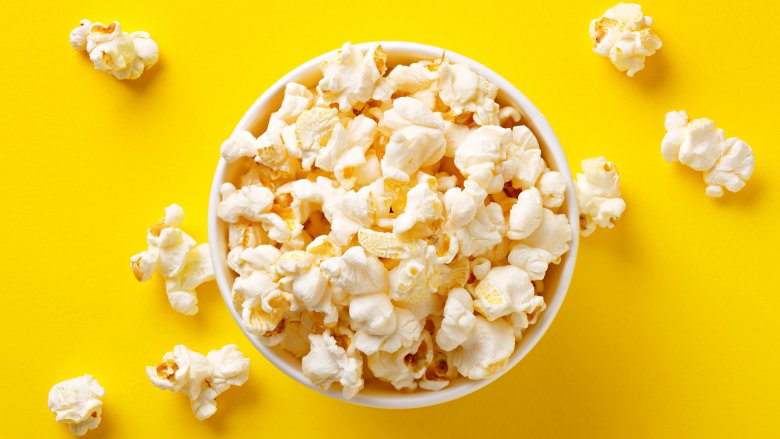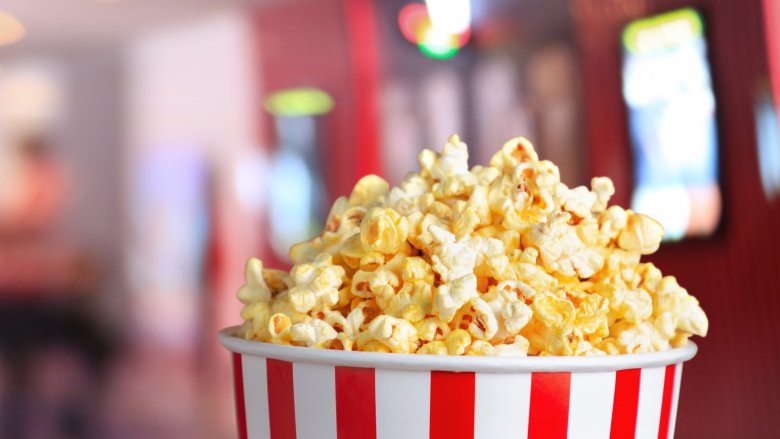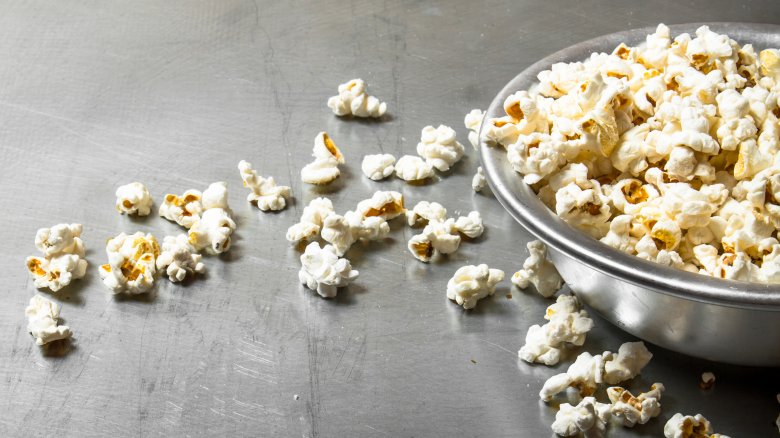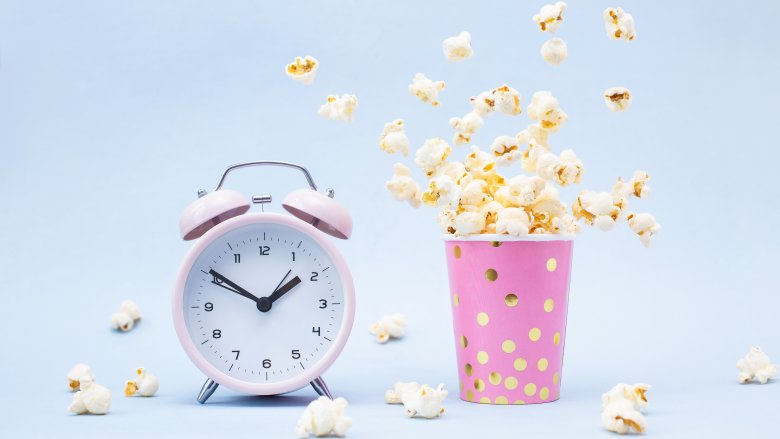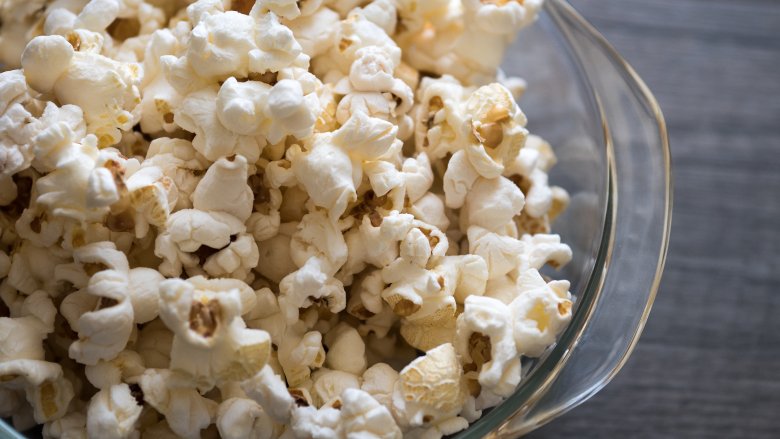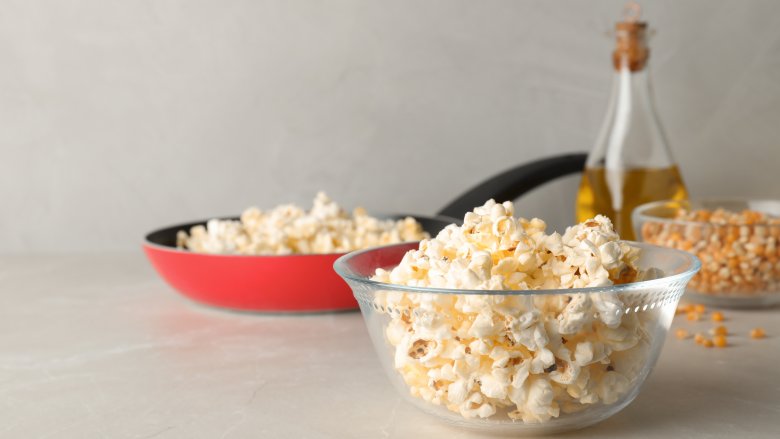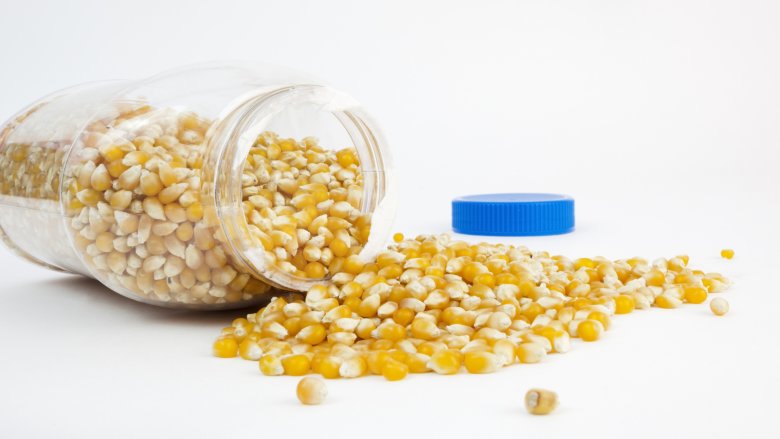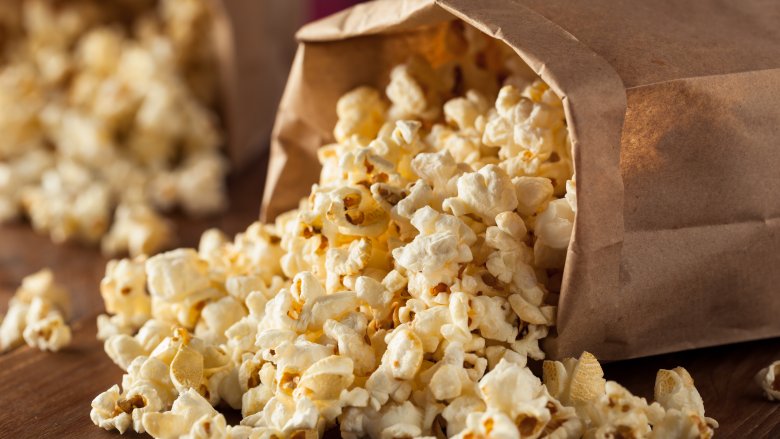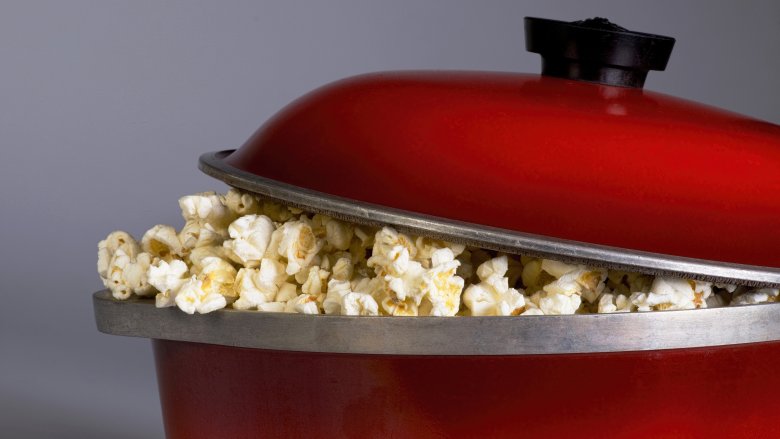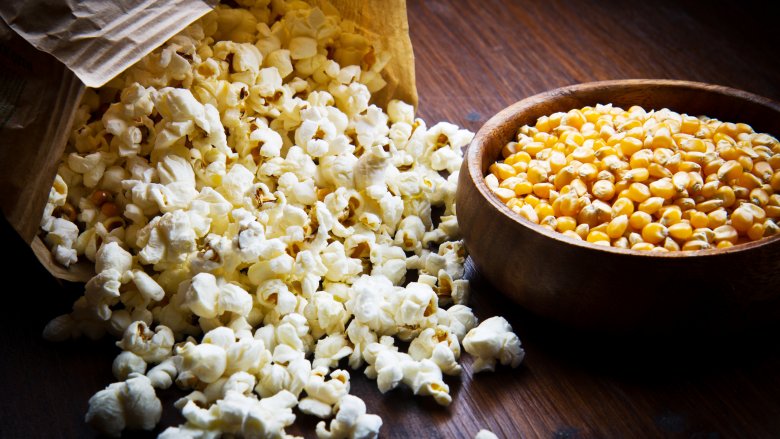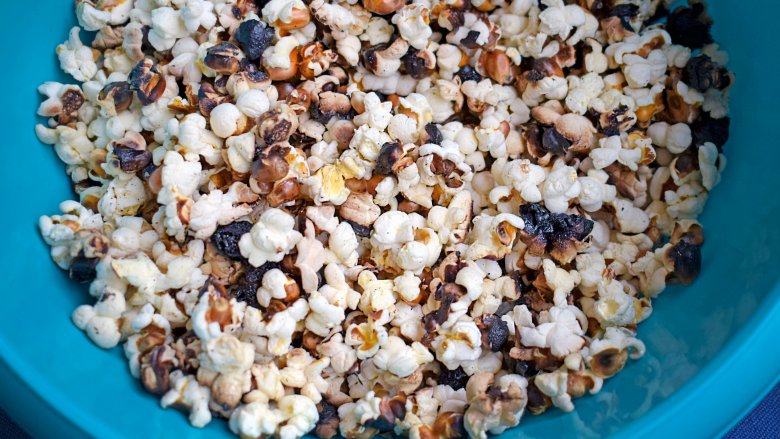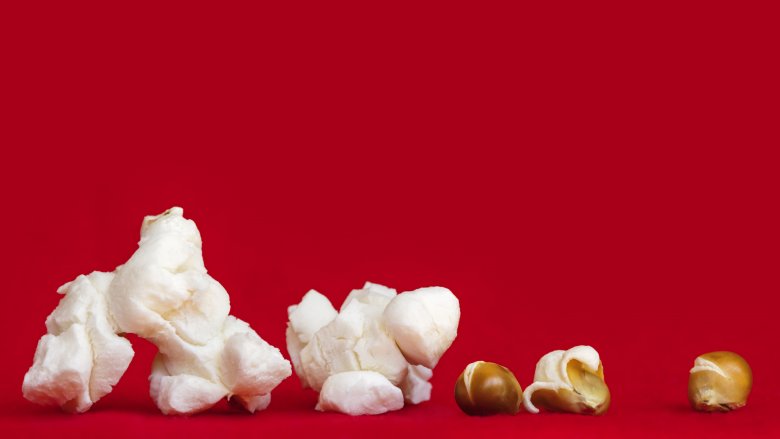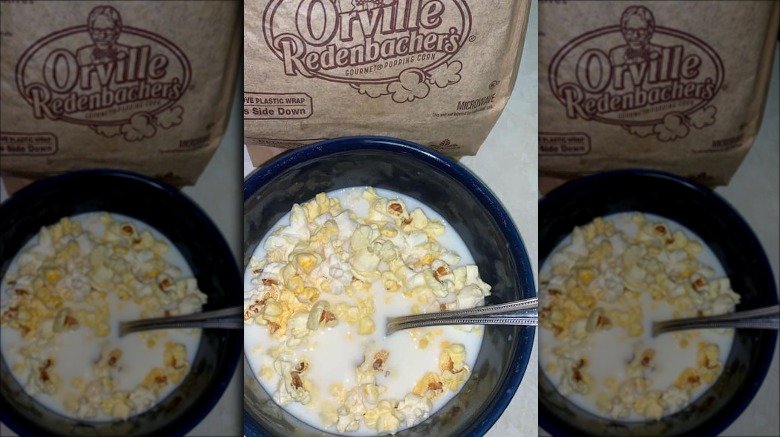Mistakes Everyone Makes When Making Popcorn
It seems like it would be a no-brainer to pull off a batch of perfect popcorn — it's a pretty simple recipe, after all. At its base, stovetop popcorn is literally nothing more than kernels and oil, and depending on which microwave method you use, it might even be just one ingredient: kernels. After that, how you season it is up to you. What could go wrong?
A lot, as it turns out. Maybe you're trying to go super low-cal and try the ol' "water only" popping method. Maybe you think salting the kernels before you start popping is the way to go. Or maybe you aren't using Alton Brown's smart popcorn popping tip. These, among plenty of other mistakes, can result in a bowl of popcorn that's either chewy, burnt, unpopped, or under-seasoned. Don't think there could possibly be that many ways to screw up such a simple snack? You just might need a bowl to get through all these popcorn-making faux pas, but the good news is, we'll tell you how to fix 'em, too.
You're not using this secret ingredient
If you think movie theater popcorn is the only popcorn worth eating, but you've never been able to replicate that distinct flavor at home, it's because you probably aren't using Flavacol.
Flavacol is the secret ingredient that makes movie theater popcorn taste like, well, movie theater popcorn. "The fine salt flakes stick to the popcorn, whereas a ground salt will tend to fall off. Contains just the right blend of Yellow #5 and #6 colors to give popcorn a bright appealing yellow color," promises its product description. And a 35-ounce carton will last you hundreds of batches, so we can only assume that this is some potent stuff.
How do you use it? According to an in-the-know Redditor with plenty of Flavacol experience, "The best recipe for at home theatre popcorn is what I call '1.2.3.4': 1/2 cup popcorn to 3/4 teaspoon Flavacol. Use just a small glug of oil, you don't need much. Note 1: If you use that nasty a** orange coconut oil it's exactly the same as theatre popcorn. I use corn oil and I prefer it. Note 2: If your pan is a sticky mess at the end, you've got it too hot. If you dial the heat in right, the cleanup is stupidly easy, just a lightly oiled pan at the end. Seriously, this recipe is so good, that I no longer use any butter..."
You're not using Alton Brown's trick
Think an electric popcorn popper is the only way to ensure perfect popcorn every time? According to Alton Brown, if you have a heavy gauge, 6-quart stainless steel bowl, you "already have a perfect corn popper in hand."
In an episode of Good Eats, Brown explains why the stainless steel bowl is the perfect vessel, saying, "The oil and unpopped kernels pool at the bottom where the heat is the greatest, while popped kernels rise up the side away from the heat so that they don't burn." As a bonus, once the bowl is cooled, it doubles as a serving bowl.
Before you start popping, Brown has one more piece of advice: Pulse your kosher salt in the food processor to make fine salt, which sticks to the popcorn better.
Now that you're armed with all this knowledge, put 3 tablespoons of neutral oil (like peanut), 1/2 cup of kernels, and 1/2 teaspoon of fine salt into the bowl, then cover it completely with foil and poke a few holes in the top to let the steam escape. Over medium heat, use a pair of tongs to grip the edge of the bowl and shake, shake, shake, like you're making Jiffy Pop. Once it's done, butter it if you want (Brown doesn't), and be happy that you didn't buy that electric popper that was going to bogart all your counter space.
You're relying on a timer
Whether you're popping corn on the stove for a set amount of time, or using that supposedly handy "popcorn" button on the microwave, chances are you're going to burn your batch if you let either timer count down to zero. We all know that there isn't a smell more pervasive than burnt popcorn, so avoiding it at all costs is worthwhile.
But if you can't rely on a timer, how do you know when it's done? According to Popcorn.org, who should know a thing or two about perfect popcorn, "The best tip is to stay near and play it by ear. Literally. The sound of popcorn popping is your best clue to when it's ready." Whether you're using the stove or the microwave, they say that "when the popping slows, listen until you can count 2 seconds between pops." Once you can count those seconds, it's done, and there's a fine line between just right and blackened. Lift the lid or open the bag immediately and revel in your unburnt popcorn.
You use the "water only" method
We get it — you want a low-cal, low-fat snack, and popcorn fits that bill, at least until you add all the oil that's needed to pop it. So you decide to forgo the oil and just use a tablespoon of water instead, because if the internet says it works, it's got to work, right?
Well, that depends on whether or not you actually want to eat the popcorn. The Kitchn put this method to the test and the finished products were disastrous, with results ranging from burned and completely unpopped kernels, to burned and mostly unpopped kernels. Since not eating any popcorn at all qualifies as a low-cal, low-fat alternative, maybe the water-popping hack is exactly what you want. But if you actually want edible popcorn, water is definitely not the way to go.
And don't forget, there are actually oils out there that fall into the "good fat" category, so pop those kernels in a tablespoon of coconut oil and rest easy knowing that it can improve your cholesterol and boost your metabolism. By using coconut oil you've basically made popcorn a health food, is what we're saying.
You're not using enough oil
Now that we've dashed all your water-popped popcorn dreams, we also regret to inform you that you're probably not using enough oil in your popping process.
According to The New York Times' Melissa Clark, her "popcorn world exploded" when she tasted chef Jessica Koslow's recipe. "Her snow-white kernels were impeccably crunchy, glistening with fat and seasoned with just enough salt to stick to my fingers," Clark wrote. "Their initial crackle melted into a corn-flavored fluff on the tongue before completely disappearing."
The secret is oil — more than you probably want to add, but you definitely should. Koslow says of perfecting her popcorn recipe, "The large amount of oil kind of snuck up on me. Once I measured everything, I thought, wow, that's a lot more oil than I thought." She promises that the exorbitant amount of oil — a jaw-dropping 1/2 cup to 1/3 cup of kernels — will result in a crunchiness like you've never tasted, what Koslow likens to "potato chip sturdiness." Sure, it's about four times more oil than your regular popcorn recipe calls for, and yes, that's more oil than popcorn kernels, but hey, not all snacks were meant to be low-fat and bland. Live a little.
You're storing it wrong
Maybe you just couldn't pass up the amazing deal and you impulse-bought the 10-pound jug of popcorn kernels at Costco. Once you get home, though, you realize that it will probably take you somewhere around seven years to polish that bad boy off in 1/4 cup increments. Your first instinct might be to stick it in the fridge or freezer — that's how you prolong the shelf-life of nuts, so it must work with popcorn kernels, right?
Wrong. Storing popcorn kernels in the refrigerator or freezer will actually have the opposite effect that you'd hoped for — it actually dries them out, and without the moisture inside that makes the kernels pop, you'll be left with a bunch of "old maids" (a delightful name bestowed upon the unpopped kernels).
The Straight Dope tested this theory out, storing bags in the fridge, freezer, and at room temperature, and found that the longer the kernels had been stored in the fridge or freezer, the more old maids they got. Your best bet for storage is a cool place in an airtight container. Even that huge jug you bought should remain poppable to the bitter end, because popcorn doesn't truly go bad — as long as that moisture is retained inside the kernels with proper storage, you'll be able to pop a batch indefinitely.
You're not making DIY microwave popcorn
If you're still really, really stuck on that water-popping method for the driest, least flavorful popcorn you've ever put in your mouth, you're in luck. You can make microwave popcorn without having to buy that scary, bright yellow stuff that has been known in the past to cause cancer and "popcorn lung" in those who ate a lot of it.
All you need is a plain ol' brown paper bag, and you're well on your way to DIY microwave popcorn, sans the weird chemicals in the store-bought packages. Just dump about 1/4 cup of kernels into the paper bag, fold the top over a few times to prevent the popcorn popping everywhere, and start nuking. As we've already learned, you won't want to rely on the microwave's "popcorn" button here, just wait until the kernels slow to about two seconds between pops.
And just like that, you made microwave popcorn. What you do now is up to you. If you're truly committed to a low-cal, low-fat snack, you're good to go. Otherwise, drizzle some oil or butter into the bag, along with whatever seasoning you'd like, and shake, shake, shake.
You're using the wrong pot, and the pot wrong
Jiffy Pop cooks up in what amounts to a disposable pie plate — that doesn't mean that you should be using just any old pot on your journey to perfect popcorn. Make the wrong choice when it comes to your popping vessel, and you could end up with unpalatable popcorn or worse, a ruined pot.
While most experts agree that a heavy-bottomed pot is the way to go thanks to superior heat conductivity, Bon Appétit cautions against using enameled cast iron. Your coveted Le Creuset is not the pot you should reach for when it's popcorn time. Though it's probably your go-to for everything else, enameled cast iron just gets too hot for those kernels. Burnt popcorn is one thing, but a demolished Le Creuset is quite another.
No matter what pot you're using, an important thing to remember is that you've got to shake things up. At least once a minute, you'll want to agitate the pot to ensure that all the kernels get exposed equally to the heat. And as much as you'd like to keep things clean by adding the seasoning directly into the same pot you cooked the popcorn in, don't. If you throw all that flavorful salt, cheese, and any other tasty tidbits into a hot pot, they'll likely stick to the bottom before they stick to the popcorn itself. Avoid that by doing your seasoning in a bowl off the heat.
You're pre-salting it
To pre-salt, or not to pre-salt? That is the question. Because when culinary superstars like Alton Brown tell us to pre-salt, it's hard to think of any good reason not to follow his typically spot-on advice. But if you ever feel like your popcorn is just not as tender as it should be, that early salting might be the reason.
That's according to Popcorn.org, who says that "pre-salting kernels toughens popcorn." And, sorry Good Eats evangelists, but Consumer Reports agrees. They both recommend salting the popcorn once it's been popped.
If you want to add a little extra flavor, now's the time for that, too, because not thinking outside the popcorn seasoning box is another mistake you're probably making. How about adding grated Parmesan cheese, lemon zest, and black pepper? Or flaked coconut, sugar, and salt for a tropical twist on kettle corn? Would you say no to dark chocolate and chili powder? Doubtful. The possibilities truly are endless when it comes to seasoning your bowl — just remember not to salt too soon (unless you prefer tough popcorn, that is).
You're cooking it too hot and fast
Sometimes when a popcorn craving hits you need to scratch that itch fast, and if you're a stovetop-only kind of person, that means you could be looking at a good 10 minutes before you're stuffing your face with those fluffy morsels. You might think that you can shave a few minutes off by cranking up the heat, and sure, this fast-tracked approach will speed things up, if it's burnt popcorn you're craving.
According to Bon Appétit, when it comes to perfectly popped popcorn — no matter how badly you want it — you need to start with the heat on medium-high. But keep an ear out, because as soon as those first pops start, you need to turn the stove down to medium or even medium-low. Turning the heat down allows the rest of the kernels to catch up to those already popping, and this way none of them will get too hot.
As an added bonus, because you're not using a scorching hot heat to make your popcorn, you can take advantage of oils with lower smoke points that you wouldn't otherwise be able to use, which means things like olive oil and ghee are on the table. No burnt popcorn and flavored oils? Win, win.
You're not re-popping the "old maids"
A little lesson in popcorn science: Those unpopped kernels left at the bottom of your bowl are called "old maids," and they probably didn't pop simply due to a lack of moisture. Any kernel needs to contain about 13.5 percent moisture to properly pop, and according to Popcorn.org, just a few percent moisture loss can render them unpoppable.
The good news is, those old maids are no longer destined for the garbage bin. You can actually gather them all up, and once you have enough for a bowl, reconstitute and pop 'em again. All you need to do is soak the old maids in a bowl of water.
Popcorn.org says that David Woodside, author of What Makes Popcorn Pop?, recommends filling "a one-quart jar three-quarters full of popcorn and adding one tablespoon of water. Cover the jar with an airtight lid and give it a few good shakes every few minutes until the popcorn has absorbed all the water. Store the jar in a cool place." After two to three days, retest a few kernels. If they pop, you're in business. If not, add a bit more water to the mix, shake it, and try again a few days later. No more wasted popcorn kernels.
You're not eating it in milk
Say what? Popcorn in milk? Yes, it's a real snack enjoyed by real people, apparently for quite a long time. In fact, Extra Crispy calls it the "OG breakfast cereal."
According to The New York Times, way back in 1630, Native Americans introduced popcorn to the English colonists, who ate bowls of it with milk and sugar, making it the nation's "first puffed cereal." Centuries later though, we don't see this breakfast treat on hipster cafe menus, and that's a shame, because it was apparently quite a tasty combination back in the day.
Says one commenter in a Serious Eats thread discussing this unusual way of eating popcorn, "My grandparents lived on a farm in Nebraska early in the 20th century, and their six children routinely ate popcorn as cereal for breakfast covered with milk... They all said it was a delicious 'cereal'." Another chimed in, saying, "My grandpa ate his buttered, salted popcorn like cold cereal. Dumped into a bowl with milk poured over it and eaten with a spoon."
But what about the sogginess, you wonder? Extra Crispy says it's "actually pretty good" in this case — probably in the same way that any cereal must hit its ideal sog level before it really shines.
